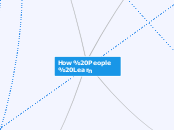How People Learn
Behaviorism
Classical Conditioning
Stimulus acquires capacity to evoke a response
Learning is reflexive
Learning is associative
Learning is automatic
GOMS Model
Treats a human like an information processor and seeks to predict skilled user behavior
What is the user's goal?
What operators can he/she use?
What methods can he/she use?
What are the selection rules?
Operant Conditioning
Learning process through which the strength of a behavior is modified by reinforcement or punishment
Reinforced behavior prevails
Punished behavior ceases
Psychological Behaviourism
A person’s psychology can be explained through observable behavior
A person's psychology includes their personality
A person's psychology includes their learning
A person's psychology includes their emotions
People learn from other people
...through Observation
...through Imitation
...through Modeling
Cognitivism
Attribution Theory
Seeks to explain the world and determine causes
Behavior observed
Intentionality determined
Attribution
Focuses on working memory during instruction
Intrinsic Load (cannot change)
Extrinsic Load (seek to minimize)
Germane Load (seek to maximize)
Elaboration Theory
Optimizes the achievement of learning goals by organizing content from simple to complex
Expertise Theory
Development of talents across different fields
Functional Context Theory
Primarily used to educate adults in business and
the military
Works best when teachers know their students
Students' personal experiences are relevant
Contextualizing an activity is important
Gestalt Theory
Asserts that learning takes place through comprehension in of content in its entirety
Proximity
Similarity
Continuity
Closure
Symmetry & Order
Figure/Ground
Common Fate
Information Processing Theory
The mind works like a computer
Sensory Memory
Working Memory
Long-term Memory
Metacognition
'Thinking about your own thinking'
Knowledge of Cognition
Regulation of Cognition
Situated Cognition
Knowledge is embedded in the situation including...
Activity
Context
Culture
Stages of Cognitive Development
Looks at the stages of development in children
Sensorimotor (0 - 2 years)
Preoperational (2 - 4 years)
Concrete (7 - 11 years)
Formal (11 - 15 years)
Anchored Instruction
Uses 'anchor material' to create a shared experience to begin further learning
Experience should be short, only to introduce
Experience should be engaging, to evoke thinking, discussion and construction
Experience should be understandable - otherwise very little would happen hereafter!
Cognitive Apprenticeship
Brings tacit processes into the open, so that others can learn from them and build on them
Modeling
Coaching
Scaffolding
Articulation
Reflection
Exploration
Communal Constructivism
There is currently no expert knowledge or research to underpin knowledge in an area
Communities of Practice
Groups whose members share a passion and interact regularly to do it better
There must be a domain (field)
There must be a community (group)
There must be a practice (action)
Connectivism
Internet technologies have created new opportunities for people to learn and share information across the World Wide Web and among themselves
Radical Constructivism
Learners have no way of knowing what that reality might be
Emphasis on the experiences of the learner
Learner differences are important
Highlights the importance of uncertainty
Relational Constructivism
Relational consequence of radical constructivism
Learners cannot overcome their limited conditions of reception
Highlights learner perceptions
Social Constructivism
Addresses the collaborative and social dimensions of learning
Social Development Theory
Argues that social interaction precedes development; consciousness and cognition are the end product of socialization and social behavior
Social interaction
More Knowledgeable Other (MKO)
Zone of Proximal Development (ZPD)
Media & Technology Theories and
21st Century Learning
21st Century Learning
Digital Citizenship
State of having access to the Internet and communication technologies that help promote equal opportunity, democracy, technology skills, and human rights
Educational Robotics & Constructionism
Emphasizes student-centered discovery learning
Description of how electronic educational technology can be used and designed to promote effective learning
Multimedia principle: combination of media
Modality principle: different modes used in conjunction
Coherence principle: present what's relevant
Contiguity principle: present relevant information close together
Segmenting principle: present information in chunks
Learner control principle: learner is in the 'driver seat'
Personalization principle: tone of voice, 'humanity' in learning
Pre-training principle: prior knowledge given
Redundancy principle: not presenting the same information twice, even if in a different modality or media
Expertise effect: correct instructional methods
Game Reward Systems
Structure of rewards and incentives in a game that inspire intrinsic motivation in the player while also offering extrinsic rewards
Online Collaborative Learning
Constructivist teaching that takes the form of instructor-led group learning online
Idea generation to begin
Idea organisation to collate and categorize
Intellectual convergence to synthesize
Affordance Theory
(Digital) environment provides the opportunity
for action
21st Century Learning
Competencies required for learning and living in the 21st century
Critical thinking
Communication
Collaboration
Creativity
Flipped Classrooms
Students watch videos or listen to lectures at home
